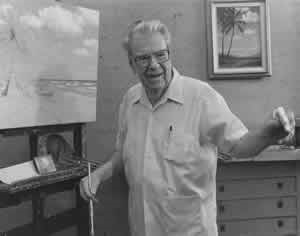A. E. "Bean " Backus
Painter

1906 - 1990
Inducted in 1993
Biography
Largely self-taught artist A.E. "Beanie" Backus painted and sold realistic scenes of his native state for 54 years. Considered the "dean" of Florida landscape art, Backus exhibited a style that inspired—and was emulated by— hundreds of artists. His lifelong, intensive study of native flora and fauna gave him a naturalist's eye for detail in his paintings. Combined with his masterful uses of light and color, this insight helped him capture the natural beauty of Florida scenery with uncanny skill and precision.
Born Albert Ernest Backus in Ft. Pierce in 1906, Backus grew up with parents who recognized and encouraged his interest in painting as a child. A nickname, "Beanie," stuck when a neighbor noticed Albert's love of most any type of bean. Just before his high school graduation, in 1924 he dropped out to work to raise money to go to the Parsons School of Design and Art in New York, where he received all of his formal training.
Once back home, Backus found work as a commercial artist, painting restaurant murals, backdrops for theaters and doing promotional work for developers. But Florida's first real estate bubble soon burst, and the state's sudden economic malaise cost Backus his job.
Undaunted, Backus, at age 25, began selling his paintings for as little as $5 at art shows around the state. Fortune struck in 1931 when a Ft. Pierce patron, Dorothy Binney Palmer, sponsored a one-man exhibition of Backus's work. The event helped opened the door to national exposure for the Ft. Pierce artist.
In 1939, a painting Backus submitted to a national competition sponsored by the IBM Corporation was picked to represent Florida for an exclusive exhibit of American art in San Francisco. On the heels of this national recognition, Backus won the "Bemis" award from the Florida Federation of Arts, the organization's top honor for state artists.
World War II saw Backus serving a stint in the U.S. Navy, but his service didn't unduly interrupt his painting. His many ports of call, including Tahiti and Bora Bora, inspired many paintings of lush, sea-island landscapes during his war-time duty, most of it spent aboard the troop transport U.S.S. Hermitage.
After the war, Backus became a fixture at such prominent Florida art showcases as the Fairchild Tropical Gardens Art Show in Miami. His work became highly popular, and commissions kept him confined to his studio in Ft. Pierce. But even during his busiest years, he found time to give free art lessons on weekends, and to serve as a mentor to dozens of students.
One of his students of the early 1950s was Alfred Hair (1941-1970), a local Black American artist who also had an eye for Florida scenery. Hair, along with fellow Florida artist Harold Newton (1934-1994), were heavily influenced by Backus's characteristic painting technique using a palette knife to apply thick strokes of vivid colors.
Hair and Newton went on to influence a group of Florida Black American artists who made their livings selling paintings at roadside stands throughout Central and South Florida. In the 1990s, the group (of 26 artists) became famous as "The Highwaymen" when critics recognized their collective work as serious art. Today, the legacy of the Florida Highwaymen is well understood to have begun in the Ft. Pierce studio of "Bean" Backus.
In 1955, Backus's wife of five years died tragically from complications following open heart surgery. He retreated to the Caribbean, and found solace particularly in Jamaica where he was captivated by the island's tropical splendor. His Jamaican paintings met an enthusiastic welcome among lovers of landscape art back in his native state.
Thirty years before his death at age 84 in 1990, the A.E. Backus Gallery and Museum was founded two blocks from Backus's home and original studio. Today, the gallery remains the largest repository of original Backus paintings in the world.
During his career, Backus finished an estimated 5,000 paintings. His work spawned countless imitators and is still considered the all-time signature art representing the beauty, grandeur and diversity of Florida's unique outdoors.
Related Links
- A.E. Backus Museum & Gallery - http://www.backusgallery.com/
- The Highwaymen, an article by Jim Fitch

